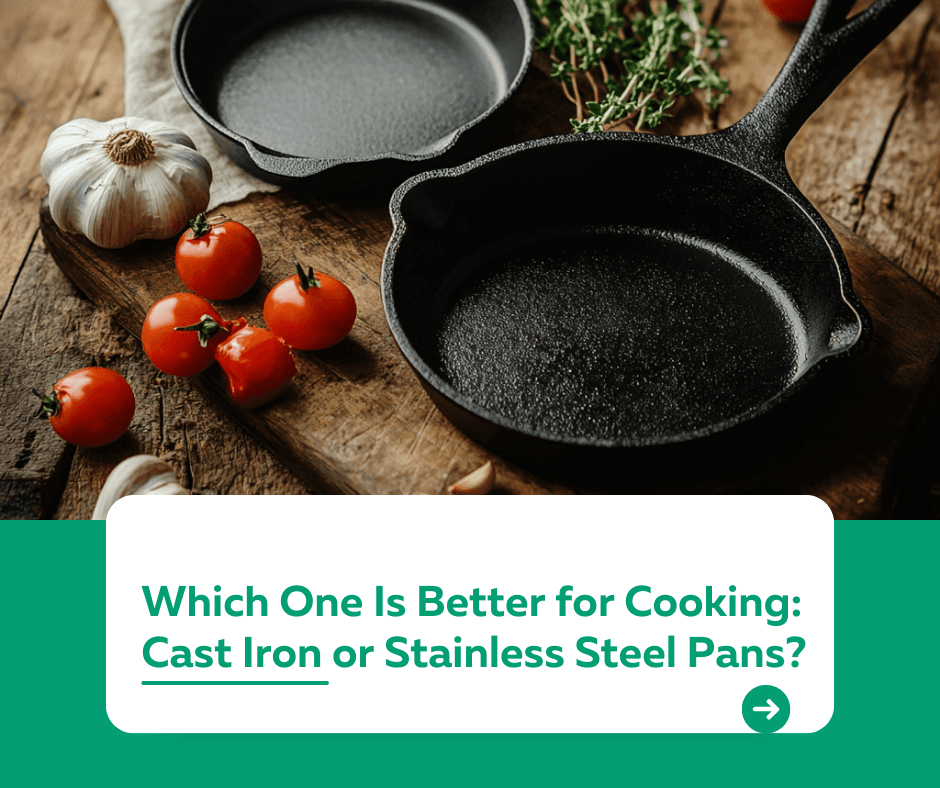
Introduction
“Which one is better for cooking: cast iron or stainless steel pans?”
Choosing the right pan can significantly impact your cooking experience and the results you achieve. Cast iron and stainless steel pans are both staples in the kitchen, but they have distinct characteristics that make them suitable for different cooking methods. Let’s explore their pros, cons, and the best scenarios for using each type of pan.
1. The Advantages of Cast Iron Pans
Cast iron pans are beloved for their durability, heat retention, and versatility. They’ve been used for centuries and are known for their ability to enhance flavors over time through seasoning.
- Pros:
- Exceptional heat retention and even distribution.
- Naturally non-stick when properly seasoned.
- Durable and long-lasting, often passed down as heirlooms.
- Ideal for high-heat cooking like searing, frying, and baking.
- Cons:
- Requires regular seasoning to maintain non-stick properties.
- Heavy and not as easy to maneuver.
- Susceptible to rust if not cared for properly.
Best Uses: Cast iron pans excel at searing steaks, frying chicken, and baking dishes like cornbread or cobblers.
2. The Advantages of Stainless Steel Pans
Stainless steel pans are prized for their sleek appearance, durability, and versatility. They are a go-to choice for professional chefs and home cooks alike.
- Pros:
- Highly durable and resistant to rust or corrosion.
- Non-reactive, making them ideal for cooking acidic foods like tomato sauce.
- Lightweight and easy to handle.
- Requires minimal maintenance compared to cast iron.
- Cons:
- Poor heat retention compared to cast iron.
- Foods may stick if not cooked with the proper technique (e.g., preheating and oiling).
Best Uses: Stainless steel pans are perfect for sautéing vegetables, deglazing sauces, and cooking delicate proteins like fish.
3. Comparing Heat Retention and Distribution
- Cast Iron: Known for its ability to retain heat, making it ideal for slow cooking and dishes that need consistent heat.
- Stainless Steel: Heats up quickly but doesn’t retain heat as well. Best for quick cooking techniques and precise temperature control.
4. Maintenance and Care
- Cast Iron:
- Requires regular seasoning to maintain its non-stick surface.
- Must be dried thoroughly after washing to prevent rust.
- Stainless Steel:
- Easy to clean and dishwasher-safe in most cases.
- Does not require seasoning.
Tip: If you prefer low-maintenance cookware, stainless steel might be a better choice.
5. Which One Should You Choose?
The decision ultimately depends on your cooking style and the types of dishes you prepare most often:
- Choose Cast Iron if you frequently cook high-heat recipes, enjoy the benefits of seasoning, and don’t mind the maintenance.
- Choose Stainless Steel if you prefer lightweight, easy-to-clean pans and often cook acidic dishes or delicate foods.
Conclusion
Both cast iron and stainless steel pans have unique advantages that make them indispensable tools in the kitchen. By understanding their strengths and weaknesses, you can choose the right pan to elevate your cooking experience.
For more kitchen tips and guides, visit our Kuestion.com.